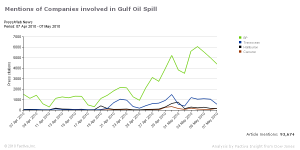When There’s Enough Blame to Go Around, It’s Rarely Spread Equally
We’ve seen it before.
A negative event happens and the negative sentiment is attached almost exclusively to the most well-known brand involved, and not to the other brands who often should share the blame. Not too long ago we can remember the case of Dell catching all the negative press when the Sony batteries in its laptops overheated and caught fire. And does anyone know the name of Toyota’s brake supplier?
This month, the obvious example is the oil disaster in the Gulf of Mexico. BP is the name nearly exclusively associated with the event in the public’s consciousness. But BP Plc didn’t even own the rig which exploded on April 20; it had been leasing it from Switzerland’s Transocean Ltd.
However, the still evolving story seems to indicate BP does not deserve all the blame. And it fact while it is accepting responsibility for clean up, it is pointing fingers at Transocean, one of three other companies involved to some degree in the event. Those other companies have been much less mentioned in the press and social media.
Houston-based oil and gas equipment and services company Halliburton was the company who was engaged in the now notorious well-cementing operations around the time of the explosion. And Houston’s well-servicer Cameron International made the blowout preventer device, which failed to engage completely. Had that failsafe worked as designed, this story would be gone from the front page by now.
An analysis of these four companies on Twitter, on blogs and boards and in the mainstream press shows a consistent picture. Household name BP has gotten the lion’s share of the press, arguably more than the others combined.
In Twitter comments, Cameron is virtually absent, perhaps enjoying its anonymity outside the oil industry. Only the testimony that Halliburton and TrasnOcean have had to give to Congress this week has gotten them into the consciousness of the Twittersphere.

Mentions on Twitter of BP, Halliburton and Transocean in the days before and after the oil rig explosion in the Gulf. There were virtually no mentions of Cameron. Source: trendistic.com
In the mainstream press, BP still tops the others. Halliburton, well-known for its activity in the other “Gulf” as a contractor for the U.S. governement, has gotten less than 10% of the mentions of BP, running about 5000 per day for BP to 400 per day for Halliburton of the approximately 20,000 sources analyzed using Dow Jones Insight. Transocean, is continually more than Halliburton in the press, on several days last week about four times as much.

Mentions of BP, Halliburton, Transocean and Cameron in the mainstream media, before and after the event. Source: Dow Jones Insight.
But in Social Media the name Halliburton probably has struck that familiar bad-guy chord and bloggers are talking about it nearly twice as much as Transocean.
How have these companies reacted to the event? BP has been looking straight at the microphones. Its CEO, Tony Hayward, has for example, been interviewed multiple times by NPR and others on exactly how his company is reacting. The company has created a web site and a feed on Twitter, focused on its response to the cleanup efforts. And it has created a crisis center in Houston, according to PR Week, “staffed by communications professionals flown in from BP’s offices around the world.”
The others companies seem a bit more camera shy. Halliburton hasn’t said much more than it did its job properly and completed it hours before the explosion.
I can’t find a Twitter feed for the other companies. Though I found one called TransoceanRumor, which clearly means Transocean isn’t driving the social media conversation, they are being driven.
Glenn Fannick is the director of product development for Dow Jones Insight, a media measurement tool. He is based in Princeton, N.J.
Read Full Post | Make a Comment ( None so far )



